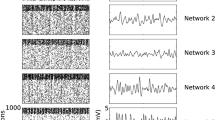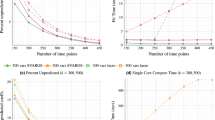Abstract
In this work we use numerical simulation to investigate how the temporal length of the data affects the reliability of the estimates of brain connectivity from EEG time-series. We assume that the neural sources follow a stable MultiVariate AutoRegressive model, and consider three connectivity metrics: imaginary part of coherency (IC), generalized partial directed coherence (gPDC) and frequency-domain granger causality (fGC). In order to assess the statistical significance of the estimated values, we use the surrogate data test by generating phase-randomized and autoregressive surrogate data. We first consider the ideal case where we know the source time courses exactly. Here we show how, expectedly, even exact knowledge of the source time courses is not sufficient to provide reliable estimates of the connectivity when the number of samples gets small; however, while gPDC and fGC tend to provide a larger number of false positives, the IC becomes less sensitive to the presence of connectivity. Then we proceed with more realistic simulations, where the source time courses are estimated using eLORETA, and the EEG signal is affected by biological noise of increasing intensity. Using the ideal case as a reference, we show that the impact of biological noise on IC estimates is qualitatively different from the impact on gPDC and fGC.













Similar content being viewed by others
Notes
In literature, this type of surrogate data is also known as Fourier transform surrogate data (Faes et al. 2004).
In order to simulate \(\{ {\varvec{x}}(t_p)\}_{p=1}^P\) we modified the Matlab code available at http://neuroinformation.incf.org.
We observe that either the frontal yellow dipole or the ten sources just described are not connected with anyone of the other dipoles of the networks. However, while the latter are used to simulate biological noise the former contributes to the scalp potential of interest and is used to evaluate the sensitivity of each connectivity measure to false positive.
We show only the results obtained when the statistical test is performed using AR surrogate data. The results with PR surrogate data are almost equal.
References
Astolfi L, Cincotti F, Mattia D, Marciani MG, Baccala LA, de Vico Fallani F, Salinari S, Ursino M, Zavaglia M, Ding L et al (2007) Comparison of different cortical connectivity estimators for high-resolution EEG recordings. Hum Brain Mapp 28(2):143–157
Baccalá L, Sameshima K (2014) Multivariate time-series brain connectivity: a sum up. Methods in brain connectivity inference through multivariate time series analysis. CRC Press, Boca Raton, pp 245–251
Baccalá LA, Sameshima K, Takahashi DY (2007) Generalized partial directed coherence. In: 15th International Conference on Digital Signal Processing (DSP’07), IEEE, pp 163–166
Baccalá LA, De Brito CS, Takahashi DY, Sameshima K (2013) Unified asymptotic theory for all partial directed coherence forms. Philos Trans R Soc A 371(1997):20120, 158
Barnett L, Seth AK (2014) The MVGC multivariate Granger causality toolbox: a new approach to Granger-causal inference. J Neurosci Methods 223:50–68
Bastos A, Schoffelen J (2015) A tutorial review of functional connectivity analysis methods and their interpretational pitfalls. Front Syst Neurosci 9:175
Bonita JD, Ambolode LCC II, Rosenberg BM, Cellucci CJ, Watanabe TAA, Rapp PE, Albano AM (2014) Time domain measures of inter-channel EEG correlations: a comparison of linear, nonparametric and nonlinear measures. Cogn Neurodyn 8(1):1–15
Brookes MJ, Hale JR, Zumer JM, Stevenson CM, Francis ST, Barnes GR, Owen JP, Morris PG, Nagarajan SS (2011a) Measuring functional connectivity using MEG: methodology and comparison with fcMRI. NeuroImage 56(3):1082–1104
Brookes MJ, Woolrich M, Luckhoo H, Price D, Hale JR, Stephenson MC, Barnes GR, Smith SM, Morris PG (2011b) Investigating the electrophysiological basis of resting state networks using magnetoencephalography. Proc Natl Acad Sci 108(40):16783–16788
Brookes MJ, Woolrich MW, Barnes GR (2012) Measuring functional connectivity in MEG: a multivariate approach insensitive to linear source leakage. NeuroImage 63(2):910–920
Chella F, Marzetti L, Pizzella V, Zappasodi F, Nolte G (2014) Third order spectral analysis robust to mixing artifacts for mapping cross-frequency interactions in EEG/MEG. NeuroImage 91:146–161
Corbetta M, Shulman GL (2002) Control of goal-directed and stimulus-driven attention in the brain. Nat Rev Neurosci 3(3):201–215
Cui J, Xu L, Bressler SL, Ding M, Liang H (2008) BSMART: a Matlab/C toolbox for analysis of multichannel neural time series. Neural Netw 21(8):1094–1104
de Pasquale F, Della Penna S, Snyder AZ, Lewis C, Mantini D, Marzetti L, Belardinelli P, Ciancetta L, Pizzella V, Romani GL, Corbetta M (2010) Temporal dynamics of spontaneous MEG activity in brain networks. Proc Natl Acad Sci 107(13):6040–6045
de Pasquale F, Della Penna S, Snyder AZ, Marzetti L, Pizzella V, Romani GL, Corbetta M (2012) A cortical core for dynamic integration of functional networks in the resting human brain. Neuron 74(4):753–764
Eichler M (2006) On the evaluation of information flow in multivariate systems by the directed transfer function. Biol Cybern 94(6):469–482
Engel AK, Gerloff C, Hilgetag CC, Nolte G (2013) Intrinsic coupling modes: multiscale interactions in ongoing brain activity. Neuron 80(4):867–886
Ewald A, Marzetti L, Zappasodi F, Meinecke FC, Nolte G (2012) Estimating true brain connectivity from EEG/MEG data invariant to linear and static transformations in sensor space. NeuroImage 60(1):476–488
Faes L, Pinna GD, Porta A, Maestri R, Nollo G (2004) Surrogate data analysis for assessing the significance of the coherence function. IEEE Trans Biomed Eng 51(7):1156–1166
Faes L, Porta A, Nollo G (2010) Testing frequency-domain causality in multivariate time series. IEEE Trans Biomed Eng 57(8):1897–1906
Faes L, Erla S, Nollo G (2012) Measuring connectivity in linear multivariate processes: definitions, interpretation, and practical analysis. Comput Math Methods Med 2012
Faes L, Erla S, Porta A, Nollo G (2013) A framework for assessing frequency domain causality in physiological time series with instantaneous effects. Philos Trans R Soc A 371(1997):20110,618
Fraschini M, Demuru M, Crobe A, Marrosu F, Stam C, Hillebrand A (2016) The effect of epoch length on estimated EEG functional connectivity and brain network organisation. J Neural Eng 13(3):036,015
Geweke J (1982) Measurement of linear dependence and feedback between multiple time series. J Am Stat Assoc 77(378):304–13
Granger C (1969) Investigating causal relations by econometric models and cross-spectral methods. Econometrica. 424–438
Haufe S, Nikulin VV, Müller KR, Nolte G (2013) A critical assessment of connectivity measures for EEG data: a simulation study. NeuroImage 64:120–133
Haykin SS (2008) Adaptive filter theory. Pearson Education India
Hillebrand A, Barnes GR, Bosboom JL, Berendse HW, Stam CJ (2012) Frequency-dependent functional connectivity within resting-state networks: an atlas-based MEG beamformer solution. NeuroImage 59(4):3909–3921
Hincapié A, Kujala J, Mattout J, Daligault S, Delpuech C, Mery D, Cosmelli D, Jerbi K (2016) MEG connectivity and power detections with minimum norm estimates require different regularization parameters. Comput Intell Neurosci 2016:19
Holmes CJ, Hoge R, Collins L, Woods R, Toga AW, Evans AC (1998) Enhancement of MR images using registration for signal averaging. J Comput Assist Tomogr 22(2):324–333
Liu S, Molenaar P (2016) Testing for granger causality in the frequency domain: A phase resampling method. Multivar Behav Res 51(1):53–66
Liuzzi L, Gascoyne LE, Tewarie PK, Barratt EL, Boto E, Brookes MJ (2017) Optimising experimental design for MEG resting state functional connectivity measurement. NeuroImage 155:565–576
Lütkepohl H (2007) New introduction to multiple time series analysis. Springer, New York
Marzetti L, Del Gratta C, Nolte G (2008) Understanding brain connectivity from EEG data by identifying systems composed of interacting sources. NeuroImage 42(1):87–98
Marzetti L, Della Penna S, Snyder AZ, Pizzella V, Nolte G, de Pasquale F, Romani GL, Corbetta M (2013) Frequency specific interactions of MEG resting state activity within and across brain networks as revealed by the multivariate interaction measure. NeuroImage 79:172–183
Nolte G, Dassios G (2005) Analytic expansion of the EEG lead field for realistic volume conductors. Phys Med Biol 50(16):3807
Nolte G, Bai O, Wheaton L, Mari Z, Vorbach S, Hallett M (2004) Identifying true brain interaction from EEG data using the imaginary part of coherency. Clin Neurophysiol 115(10):2292–2307
Nunez P, Srinivasan R, Westdorp A, Wijesinghe R, Tucker D, Silberstein R, Cadusch P (1997) EEG coherency. I. Statistics, reference electrode, volume conduction, Laplacians, cortical imaging, and interpretation at multiple scales. Electroencephalogr Clin Neurophysiol 103(5):499–515
Oostenveld R, Fries P, Maris E, Schoffelen JM (2011) FieldTrip: open source software for advanced analysis of MEG, EEG, and invasive electrophysiological data. Comput Intell Neurosci 2011
Papoulis A, Pillai S (2002) Probability, random variables, and stochastic processes. McGraw-Hill, New York
Pascual-Marqui RD (2007) Discrete, 3D distributed, linear imaging methods of electric neuronal activity. Part 1: exact, zero error localization. arXiv:07103341
Pascual-Marqui RD, Lehmann D, Koukkou M, Kochi K, Anderer P, Saletu B, Tanaka H, Hirata K, John ER, Prichep L, Biscay-Lirio R, Kinoshita T (2011) Assessing interactions in the brain with exact low-resolution electromagnetic tomography. Philos Trans R Soc A 369(1952):3768–3784
Pereda E, Quiroga RQ, Bhattacharya J (2005) Nonlinear multivariate analysis of neurophysiological signals. Prog Neurobiol 77(1):1–37
Prichard D, Theiler J (1994) Generating surrogate data for time series with several simultaneously measured variables. Phys Rev Lett 73(7):951
Sakkalis V (2011) Review of advanced techniques for the estimation of brain connectivity measured with EEG/MEG. Comput Biol Med 41(12):1110–1117
Schelter B, Winterhalder M, Timmer J (2006) Handbook of time series analysis: recent theoretical developments and applications. Wiley, Weinheim
Schoffelen JM, Gross J (2009) Source connectivity analysis with MEG and EEG. Hum Brain Mapp 30(6):1857–65
Schreiber T, Schmitz A (1996) Improved surrogate data for nonlinearity tests. Phys Rev Lett 77(4):635
Schreiber T, Schmitz A (2000) Surrogate time series. Physica D 142(3):346–382
Silfverhuth MJ, Hintsala H, Kortelainen J, Seppänen T (2012) Experimental comparison of connectivity measures with simulated EEG signals. Med Biol Eng Comput 50(7):683–688
Stam CJ (2010) Use of magnetoencephalography (MEG) to study functional brain networks in neurodegenerative disorders. J Neurol Sci 289(1–2):128–234
Stam CJ, van Straaten EC (2012) Go with the flow: use of a directed phase lag index (dPLI) to characterize patterns of phase relations in a large-scale model of brain dynamics. NeuroImage 62(3):1415–28
Theiler J, Eubank S, Longtin A, Galdrikian B, Farmer JD (1992) Testing for nonlinearity in time series: the method of surrogate data. Physica D 58(1):77–94
Van Diessen E, Numan T, van Dellen E, van der Kooi AW, Boersma M, Hofman D, van Lutterveld R, van Dijk BW, van Straaten ECW, Hillebrand A, Stam CJ (2015) Opportunities and methodological challenges in EEG and MEG resting state functional brain network research. Clin Neurophysiol 126(8):1468–81
Wang HE, Bénar CG, Quilichini PP, Friston KJ, Jirsa VK, Bernard C (2014) A systematic framework for functional connectivity measures. Front Neurosci 8:405
Welch P (1967) The use of fast fourier transform for the estimation of power spectra: a method based on time averaging over short, modified periodograms. IEEE unified asyptotics on audio and electroacoustics 15(2):70–73
Wendling F, Ansari-Asl K, Bartolomei F, Senhadji L (2009) From EEG signals to brain connectivity: a model-based evaluation of interdependence measures. J Neurosci Methods 183(1):9–18
Wiener N (1956) The theory of prediction. Modern mathematics for engineers 1:125–139
Acknowledgements
The authors thank the anonymous reviewers for their valuable comments and suggestions. L.M. and V.P. have been supported in part by the grant Functional connectivity and neuroplasticity in physiological and pathological aging, PRIN 20102011 n. 2010SH7H3F_006, and by the grant Breaking the Nonuniqueness Barrier in Electromagnetic Neuroimaging (BREAKBEN), H2020-FETOPEN-2014-2015/H2020-FETOPEN-2014-2015-RIA, Project reference: 686865.
Author information
Authors and Affiliations
Corresponding author
Additional information
This is one of several papers published together in Brain Topography on the “Special Issue: Controversies in EEG Source Analysis”.
Rights and permissions
About this article
Cite this article
Sommariva, S., Sorrentino, A., Piana, M. et al. A Comparative Study of the Robustness of Frequency-Domain Connectivity Measures to Finite Data Length. Brain Topogr 32, 675–695 (2019). https://doi.org/10.1007/s10548-017-0609-4
Received:
Accepted:
Published:
Issue Date:
DOI: https://doi.org/10.1007/s10548-017-0609-4




